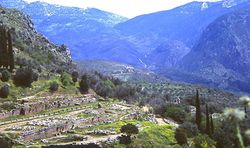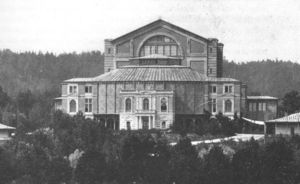What is the history of music festivals
Outdoor music festivals have become a fixture of summertime for many adults. Many different music genres now have their own festivals and some of the largest in the world, such as Glastonbury or Summerfest in Milwaukee, are attended by hundreds of thousands. While music festivals appear to be a relatively recent development, at least since the rise of Rock and more liberal lifestyles since the 1960s, their history goes back much further. Music festivals have always been about bringing people together to share a common cultural experience through music. This is one common element that has not changed for centuries.
The Early Development of Music Festivals
The earliest known music festival arguably occurred during the Pythian Games that took place in the 6th century BC. These games took place every four years and were similar to the well known ancient Olympic games (Figure 1). This event eventually became more focused on games and athletic competitions, but the event was initially dedicated to Apollo and focused on music, with Apollo being the patron because he was the Greek god of music. Apollo is often depicted with a lyre and the Pythian Games were a chance to hold competitions among musicians and performing groups. Both instrumental and singing performances were held as competitions among different contestants.
During the spring the Athenians celebrated the Festival of the Vine Flower, which also included large drinking contests, dancing, and music. Performances would also be held to honor Dionysus, with the festival-goers using music and their drinking to honor the god. [1]
By the high Middle Ages, between 1000-1250, music festivals and fairs became more common in towns across Europe. These festivals, similar to some of the ancient Greek festivals, were opportunities for contests and games to take place. Musical performances also became common as part of the entertainment, although generally festivals did not focus only on musical performances. Competitions would be held in different towns across Europe and many of these fairs would occur in the spring or more commonly in the summer. Festivals such as these were used as opportunities for families to connect with others or even find matches among the unmarried. Festivals, similar to today, were social but also commercial occasions for those involved.[2]
The Development of Modern Music Festivals
In the Medieval era, most of the music that took place we would perhaps today classify as folk music or local music from regions that would involve common instruments rather than regal or more formal instruments that would have developed and became popularized in the early Modern Era after the 16th century. These would have taken place at local festivals, but it is impossible to determine if the music played at the festival was just part of the experience or the entire focus of the festival.
In the 19th century, the Bayreuth Festival, in 1876 in Bavaria, became one of the first formal and annual festivals dedicated specifically to music and patronized at the highest level of government (Figure 2). This festival was patronized by King Ludwig II and was attended to by other royalty from Europe and elsewhere. The festival began as an occasion to promote the composer Richard Wagner, who wanted to popularize his music. The festival was effective in achieving this, as Wagner did become a well-known artist from the period. Furthermore, the festival continues until today, where it is the best-known and probably longest-lived modern festival dedicated to Wagner's music. For later festivals, this showed artists that music festivals could be highly effective to promote their work.[3]
In the 20th century, jazz was perhaps the first genre to take advantage of music festivals. There were many smaller venues and festivals throughout the United States and Europe in the early 20th century. Most festivals did not have financial backing the enabled them to last beyond one year or organize as such so that they could draw in hundreds of thousands of people. Most festivals were focused on local performances and, similar to Medieval festivals, incorporated various other events and not just music. The Bayreuth Festival was effectively an exception, and mostly because it had royal support. However, in the 1950s larger events began to be organized.
At first, it was the Newport Jazz Festival in 1954 that began a trend of larger venues, mainly focusing on Jazz. The movie Jazz on a Summer's Day in 1958 popularized the festival and this arguably began a trend for audiences wanting more festivals. Newport also organized festivals for folk music, with the Newport Folk Festival opening in 1959. Although not as well known as the jazz festivals, the festival did introduce Bob Dylan to audiences and helped to promote his career. In 1961, what would ultimately become one of the UK's biggest and most well-known music festivals originated as the National Jazz and Blues Festival, which would later become the Reading Festival, in Reading outside of London, that became increasingly Rock oriented and similarly derived music later on.
As rock music became one the prominent form of music in the 160s, many early artists began to use Jazz festivals, in the US and UK, to showcase rock music. This trend continued throughout most of the late 1950s and 1960s for larger rock bands, who by now became well established. This included Led Zeppelin and Jethro Tull using open-air music festivals. Organizers now began to see Rock as a genre that could attract its own festivals goers.[4]
Today's Music Festivals
By the late 1960s, Rock bands and promoters began to organize their own music festivals. Perhaps the first formal and well known dedicated festival to Rock was the Monterey Pop Festival in 1967, which featured the Who and brought that band to the attention of American audiences. Another early festival was the Isle of Wight festival, in 1968, which started as an event with about 10,000 people and featured Jefferson Airplane, Pretty Things, and Arthur Brown among its performers.
By 1970, the festival grew to bring in more than 600,000 people, showing the popularity of music festivals to organizers and causing many others to begin to imitate these events where multiple, often well-known bands would come and perform. The Summerfest festival was established in 1968, but it focused not only on music but other events and was spread out across the city of Milwaukee. Interestingly, Summerfest made cities realized that music and other festivals can be major revenue generators, particularly for struggling city budgets. This helped to spread the idea of creating not only musical festivals sponsored by cities but also other types of festivals, such as those dedicated to food and film.[5]
What perhaps put music festivals on the map and made Rock music festivals known to many Americans and Europeans was Woodstock in 1969, which featured many well-known bands and artists, including the Who and Jimi Hendrix, and drew hundreds of thousands of people, making it the first large-scale Rock music festival. It was billed as "three days of love and peace," making it the ultimate symbol of the 1960s counter-culture movement.
Interestingly, the festival almost never happened, as the governor of New York, Nelson Rockerfeller, threatened to send in the National Guard to stop the festival from taking place, where many of the locals in upstate New York did not feel it was appropriate to have such an event. In 1970, a documentary with the same name as the festival was released, which further popularized the event and encapsulated to many Americans what the late 1960s and early 1970s Rock culture represented.
Throughout the early 1970s, open-air concerts became more popular, with Led Zepplin among popular bands preferring such venues and helping to popularize them. This gave the idea to hold other music, mainly Rock, festivals, with Glastonbury being established in 1970 and, along with the Isle of Wight Festival, among the first in the UK focused on Rock. Nevertheless, Woodstock and other Rock music venues began to demonstrate that music festivals were powerful ways to popularize artists and music genres, which helped lead other forms of music to begin to imitate Rock music festivals. Furthermore, the Hippie movement did much to influence music festivals in the 1970s, sometimes crashing events, or simply bringing large crowds to events. Many of the large music festivals today, such as Isle of Wight and Summerfest, have their origins from the late 1960s and early 1970s.[6]
Conclusion
Today, it's hard to imagine summer without musical festivals. Many genres now have their own music festivals, ranging from Classical music to Heavy Metal. Countries in every habitable continent today have music festivals. Some focus on traditional, folk music, while others are geared towards younger audiences or those who prefer period-based music. Music festivals were often part of larger events, but by the mid-Twentieth century, promoters began to see music festivals holding their own weight in bringing in revenue and, at first, with Jazz and then later Rock, music festivals became very popular venues that have become well established as part of Summer culture.
References
- Jump up ↑ For more on the Pythian Games and their connection to early music festivals, see: Valavanēs, Panos. Games and Sanctuaries in Ancient Greece: Olympia, Delphi, Isthmia, Nemea, Athens. Los Angeles: J. Paul Getty Museum, 2004.
- Jump up ↑ For more on an example of Medieval festivals and music, see: Davidson, Clifford. Festivals and Plays in Late Medieval Britain. Aldershot, Hants, England ; Burlington, VT: Ashgate, 2007.
- Jump up ↑ For more on the influence of the Bayreuth Festival on music and festivals, see: Spotts, Frederic. Bayreuth: A History of the Wagner Festival. New Haven: Yale Univ. Press, 1994.
- Jump up ↑ For more on the influence of Jazz on music festivals, see: McKay, George, ed. The Pop Festival: History, Music, Media, Culture. New York: Bloomsbury Academic, 2015.
- Jump up ↑ For more on early Rock festivals, see: Inglis, Ian, ed. Performance and Popular Music: History, Place and Time. Ashgate Popular and Folk Music Series. Aldershot, Hants, England ; Burlington, VT: Ashgate, 2006.
- Jump up ↑ For more on the influence of Woodstock on musical festivals, see: Lauré, Jason. Woodstock 1969: The Lasting Impact of the Counterculture. S.l.: Skyhorse Publishing, 2018.

